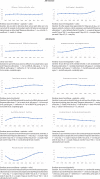Occupational trajectories of working conditions in Sweden: Development trends in the workforce, 1997-2015
- PMID: 33778895
- PMCID: PMC8259708
- DOI: 10.5271/sjweh.3955
Occupational trajectories of working conditions in Sweden: Development trends in the workforce, 1997-2015
Abstract
Objective: This study aimed to explore the development of working conditions within and between occupations in the Swedish labor market from 1997 to 2015 and whether any polarization in working conditions concurrently occurred between occupations.
Methods: Cross-sectional data from ten waves of the Swedish Work Environment Surveys (1997-2015) were used and an aggregated occupational-level dataset was created using the Swedish Standard Classification of Occupations. To capture the patterns of change in working conditions over time (ie, growth), growth curve modeling was used to identify the starting points for 89 occupations (intercepts) as well as both the shape (functional form) and rate of growth (slope) over time.
Results: The Swedish labor market was stable overall, with some small, mainly positive, changes in job demands and resources. Different occupations developed in divergent directions, but there was no evidence of polarization.
Conclusions: The findings indicate that macro-level stability can hide highly heterogeneous patterns of change among different occupational groups. This type of analysis, taking context into account, could be valuable for decision makers intending to improve the work environment.
Conflict of interest statement
The authors declare no competing interests.
Figures


Comment in
-
Monitoring trends in psychosocial and physical working conditions: Challenges and suggestions for the 21st century.Scand J Work Environ Health. 2021 Jul 1;47(5):329-333. doi: 10.5271/sjweh.3973. Epub 2021 Jun 2. Scand J Work Environ Health. 2021. PMID: 34076251 Free PMC article. No abstract available.
Similar articles
-
Working conditions and compensated sickness absence among nurses and care assistants in Sweden during two decades: a cross-sectional biennial survey study.BMJ Open. 2019 Nov 10;9(11):e030096. doi: 10.1136/bmjopen-2019-030096. BMJ Open. 2019. PMID: 31712334 Free PMC article.
-
Work stress on rise? Comparative analysis of trends in work stressors using the European working conditions survey.Int Arch Occup Environ Health. 2021 Apr;94(3):459-474. doi: 10.1007/s00420-020-01593-8. Epub 2020 Nov 1. Int Arch Occup Environ Health. 2021. PMID: 33130969 Free PMC article.
-
Can psychosocial working conditions help to explain the impact of shiftwork on health in male- and female-dominated occupations? A prospective cohort study.Chronobiol Int. 2020 Sep-Oct;37(9-10):1348-1356. doi: 10.1080/07420528.2020.1805458. Epub 2020 Sep 6. Chronobiol Int. 2020. PMID: 32893684
-
Psychosocial working conditions, trajectories of disability, and the mediating role of cognitive decline and chronic diseases: A population-based cohort study.PLoS Med. 2019 Sep 16;16(9):e1002899. doi: 10.1371/journal.pmed.1002899. eCollection 2019 Sep. PLoS Med. 2019. PMID: 31525191 Free PMC article.
-
Can a poor psychosocial work environment and insufficient organizational resources explain the higher risk of ill-health and sickness absence in human service occupations? Evidence from a Swedish national cohort.Scand J Public Health. 2019 May;47(3):310-317. doi: 10.1177/1403494818812638. Epub 2018 Nov 29. Scand J Public Health. 2019. PMID: 30486752
Cited by
-
Development of gender inequality in self-rated health in the life-phase of raising children in Germany from 1994 to 2018 - A decomposition analysis of socioeconomic, psychosocial and family-related influencing factors.SSM Popul Health. 2022 Jul 31;19:101183. doi: 10.1016/j.ssmph.2022.101183. eCollection 2022 Sep. SSM Popul Health. 2022. PMID: 36046064 Free PMC article.
-
Fifty years of research on psychosocial working conditions and health: From promise to practice.Scand J Work Environ Health. 2024 Sep 1;50(6):395-405. doi: 10.5271/sjweh.4180. Epub 2024 Aug 7. Scand J Work Environ Health. 2024. PMID: 39110008 Free PMC article. Review.
-
Development Work in Swedish Eldercare: Resources for Trustworthy, Integrated Managerial Work During the COVID-19 Pandemic.Front Public Health. 2022 Jun 30;10:864272. doi: 10.3389/fpubh.2022.864272. eCollection 2022. Front Public Health. 2022. PMID: 35844876 Free PMC article.
-
Changes in working and health conditions in different sectors between 2010 and 2019 in a representative sample of French workers.PLoS One. 2025 Jun 4;20(6):e0324244. doi: 10.1371/journal.pone.0324244. eCollection 2025. PLoS One. 2025. PMID: 40465657 Free PMC article.
-
Monitoring trends in psychosocial and physical working conditions: Challenges and suggestions for the 21st century.Scand J Work Environ Health. 2021 Jul 1;47(5):329-333. doi: 10.5271/sjweh.3973. Epub 2021 Jun 2. Scand J Work Environ Health. 2021. PMID: 34076251 Free PMC article. No abstract available.
References
-
- Bettina K, Paškvan M, Prem R, Schöllbauer J, Till M, Cabrita J, et al. Eurofound research report. Luxembourg: Publications Office of the European Union; 2019. Working conditions and workers'health; p. 80.
-
- Schütte S, Chastang JF, Malard L, Parent-Thirion A, Vermeylen G, Niedhammer I. Psychosocial working conditions and psychological well-being among employees in 34 European countries. Int Arch Occup Environ Health. 2014 Nov;87(8):897–907. https://doi.org/10.1007/s00420-014-0930-0. - PubMed
-
- Demerouti E, Bakker AB, Nachreiner F, Schaufeli WB. The job demands-resources model of burnout. J Appl Psychol. 2001 Jun;86(3):499–512. https://doi.org/10.1037/0021-9010.86.3.499. - PubMed
-
- Bakker AB, Demerouti E. The job demands–resources model:state of the art. J Manag Psychol. 2007;22(3):309–28. https://doi.org/10.1108/02683940710733115.
-
- Kivimäki M, Ferrie J, Kawachi I. Workplace stressors. In: Kivimäki M, Batty D, Steptoe A, Kawachi I, editors. The Routeldge international handbook of psychosocial epidemiology. London: Routledge; 2019. pp. 85–114.
Publication types
MeSH terms
LinkOut - more resources
Full Text Sources
Other Literature Sources

